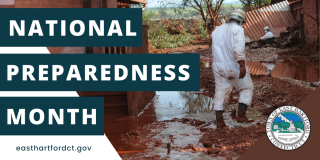September is National Preparedness Month!

National Preparedness Month is an observance each September to raise awareness about the importance of preparing for disasters and emergencies that could happen at any time.
Make a plan today. Your family may not be together if a disaster strikes, so it is important to know which types of disasters could affect your area. Disasters are costly but preparing for them doesn’t have to be. In fact, taking time to prepare now can help save you thousands of dollars and give you peace of mind when the next disaster or emergency occurs.
Take these simple steps now to be better prepared for any disaster or emergency that have little to no cost.
Step 1
Create your emergency communications plan. Put a plan together by discussing the questions below with your family, friends or household to start your emergency plan.
- How will I receive emergency alerts and warnings?
- What is my shelter plan?
- What is my evacuation route?
- What is my family/household communication plan?
- Do I need to update my emergency preparedness kit?
Download the FEMA App (available in English and Spanish) to receive weather alerts, safety tips and reminders and be ready for the unexpected.
Sign up for EH Alert to receive life-saving information from the Town of East Hartford or subscribe here for Town updates.
Step 2
Build your emergency supply kit over time. Start with items you may already have in your home, like a flashlight, extra batteries, copies of important documents, water and non-perishable food. When you go to the grocery store, you can pick up an extra item each time that you use regularly, especially if it’s on sale! Community food banks are a potential resource for food-insecure families to stock their emergency supply kits.
Consider specific needs in your household. As you prepare your plan tailor your plans and supplies to your specific daily living needs and responsibilities. Discuss your needs and responsibilities and how people in the network can assist each other with communication, care of children, business, pets or specific needs like operating medical equipment. Create your own personal network for specific areas where you need assistance. Keep in mind some these factors when developing your plan:
- Different ages of members within your household
- Responsibilities for assisting others
- Locations frequented
- Dietary needs
- Medical needs including prescriptions and equipment
- Disabilities or access and functional needs including devices and equipment
- Languages spoken
- Cultural and religious considerations
- Pets or service animals
- Households with school-aged children
Step 3
Talk with family or members of your household about where you will go if told to evacuate. Having a plan before disaster strikes can help you save precious time and money.
Create a Family Emergency Plan.
Step 4
Practice your plan with your family/household.
For more information about how to prepare for a disaster and create an emergency supply kit, visit the FEMA website.

